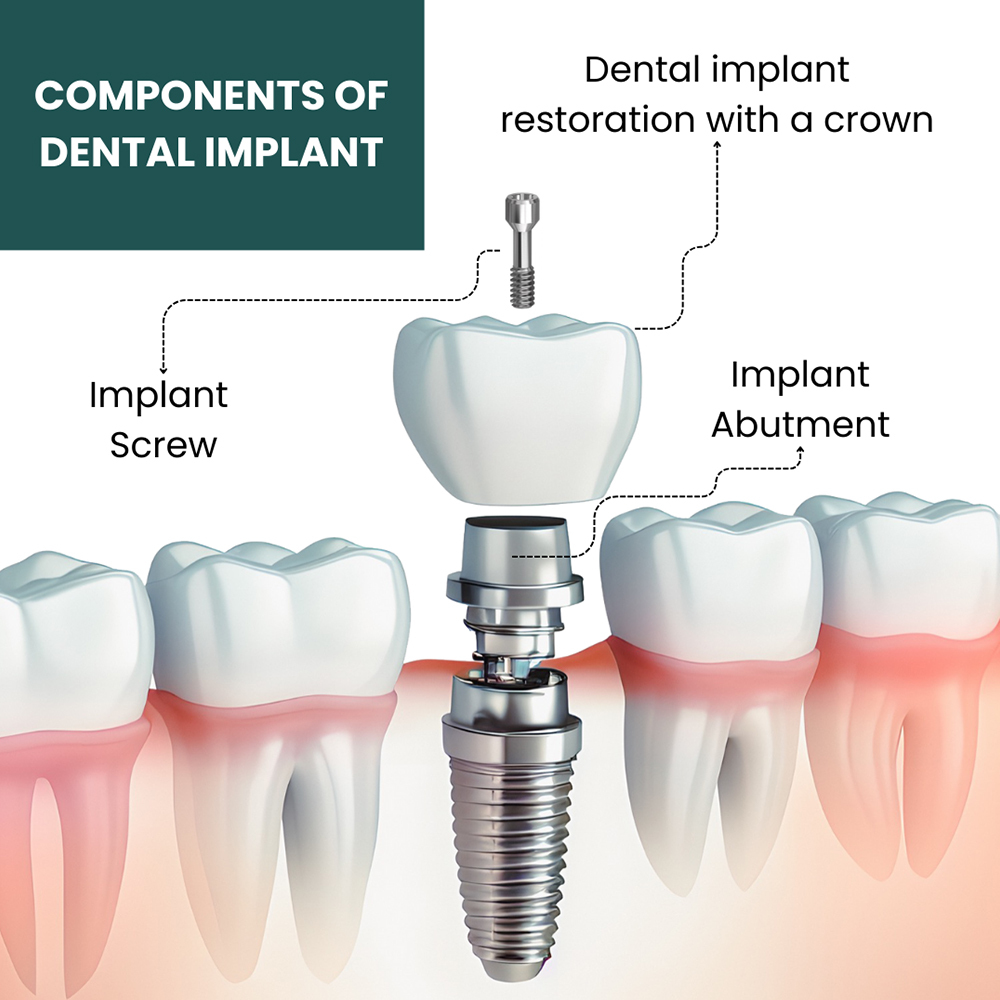The Ultimate Guide To Dental Implants
The Ultimate Guide To Dental Implants
Blog Article
Our Dental Implants Statements
Table of Contents4 Easy Facts About Dental Implants DescribedThe Only Guide for Dental ImplantsDental Implants - TruthsExcitement About Dental Implants
are clinical devices operatively dental implanted right into the jaw to recover a person's capability to chew or their look. They give support for fabricated (fake) teeth, such as crowns, bridges, or dentures. When a tooth is lost because of injury or illness, an individual can experience complications such as rapid bone loss, faulty speech, or adjustments to chewing patterns that result in discomfort.
Framework of The Dental Implant System selecting oral implants, speak to your oral provider concerning the possible benefits and threats, and whether you are a candidate for the treatment. Things to consider: Your general health is a vital variable in determining whether you are an excellent candidate for oral implants, how much time it will require to heal, and the length of time the implant might remain in location.
Smoking cigarettes may influence the healing procedure and decrease the long-term success of the dental implant. The healing process for the dental implant body might take a number of months or longer, during which time you generally have a short-term joint instead of the tooth. the dental implant treatment: Meticulously comply with the dental hygiene instructions provided to you by your dental provider.
The Ultimate Guide To Dental Implants
Implant failure can cause the demand for an additional procedure to take care of or change the dental implant system. Brings back the capacity to chew Restores aesthetic look Aids maintain the jawbone from reducing as a result of bone loss Maintains the wellness of the surrounding bone and gum tissues Aids maintain surrounding (close-by) teeth secure Enhances lifestyle Damage to surrounding natural teeth during dental implant positioning Injury to the surrounding cells throughout surgical procedure, such as sinus opening Injury during surgical treatment (as an example, fracture of surrounding jawbone) Poor feature, such as seeming like the teeth do not attack with each other usually A sensation that the tooth hangs or twisting in position arising from an abutment screw loosening Implant body failing (looseness of the dental implant body) as a result of systemic infection, which may be more probable in clients with uncontrolled diabetes mellitus because of local infection in bone and gums supporting the dental implant body due to postponed recovery, which may be more probable in clients that smoke Trouble cleaning up the gums around the dental implant, resulting in inadequate dental hygiene Untreated gum disease Post-surgical numbness due to nerve impingement or get more damages Always inform health and wellness care carriers and imaging specialists that you have dental implants prior to any type of magnetic vibration imaging (MRI) or x-ray procedures.
FDA is not mindful of any type of damaging events reported for MRI or x-ray treatments with oral implants. Dental implants systems are commonly made of products that adhere to international agreement standards of the International Organization for Standardization (ISO) or ASTM International. These criteria have details of what makes a risk-free product.
Various other materials such as gold alloys, cobalt-based alloys, titanium alloys, or ceramic materials are occasionally used. The safety and security profiles of these products are popular. Dental dental implant systems are evaluated according to worldwide consensus requirements. Biocompatibility screening, to reveal that bodily call with the gadget does not cause problems like irritability or allergy, becomes part of the assessment that helps ensure the materials in the dental implant system are safe and do not trigger damaging effects when implanted in people.

The Definitive Guide to Dental Implants
Some people are not eligible for oral implant surgical treatment. It is for oral doctors to operate individuals with: intense illnessuncontrollable metabolic diseasebone or soft cells illness or infectionIf these issues are dealt with, an individual can have the surgical treatment. Dental Implants. In, my sources oral surgeons avoid operating on people with: If individuals with any one of the above go through dental implant surgery, there is a higher threat of the dental implant stopping working
Some individuals have a jawbone irregularity that prevents adequate bone for a dental implant from developing. The surgeon will after that utilize a bone or bone substitute to fix and build up the location.
Dental dental implant surgical procedure is an individualized process. It's not the same for every person. However the following gives a basic summary of what you can anticipate your dental professional, dental surgeon, periodontist or prosthodontist to do: Put the dental implant surgically. Offer you time to recover. Connect the article and final crown, bridge hop over to these guys or denture.
Next off, your surgeon will very carefully position the dental implant into your jaw. Lastly, your doctor will certainly reposition your periodontals and shut the laceration with stitches. If your implant is near the front of your mouth, your dental expert will certainly make a temporary tooth for you to wear up until you heal. In this way, you will not have a void in your smile while you recover.
Getting My Dental Implants To Work
Your service provider can tell you what to expect in your circumstance. Throughout the healing phase, your jawbone needs to fuse to the oral implant. This procedure, called osseointegration, is critical for stability and long-lasting success. This process can take anywhere from 3 to 9 months. In some cases, it may take much longer.
As soon as your dental implant heals, your dental professional can attach the joint (little connector message) and your final reconstruction (crown, bridge or denture). This generally takes regarding one hour to complete and may require a 2nd minor surgery. You should not really feel any type of pain throughout your dental implant treatment due to the fact that your copyright will certainly use medicine to numb your gums.
Report this page